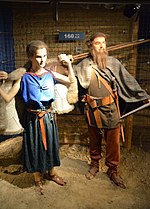Istævonere
Istævonerne var en af de tre oprindelige folkegrupper af Vestgermanerne i det nuværende Tyskland ifølge Tacitus, sammen med herminonerne (inklusive sveberne) og ingævonerne).[1] Istævoner var på Tacitus tid bosatte ved Rhinen ned til Neckar og frem til Weser. De beherskede den store grænseflods to bredder med undtagelse af Schwarzwald, hvor en svebisk stamme boede. Dette faktum gav dem dog ingen større magt efter som de, til trods for at de var i slægtsskab, ikke samarbejdede men levede i småstammer.
Istævoner mægtigste folkestamme var chatterne, og andre stammer var blandt andre sigambrere og tenkterere.
Noter
- ^ Lund, s. 91
Litteratur
- Thomas Grane: "Romerske kilder til Germaniens geografi og etnografi" (Sejrens triumf. Norden i skyggen af det romerske imperium; Nationalmuseet 2003; ISBN 87-7602-005-3; s. 126-147)
- Allan A. Lund: De etnografiske kilder til Nordens tidlige historie; Wormanium, Aarhus 1993; ISBN 87-89531-08-6
| |||||||||||||||||||||||||||||||||||||
Koordinater: 47°30′N 7°30′Ø / 47.5°N 7.5°Ø
Medier brugt på denne side
Forfatter/Opretter: Silar, Licens: CC BY-SA 3.0
Man and women of fine, slender build, long narrow heads and fine features. The women wears a blue line shirts without sleeves, red-trimmed at neck and shoulder edges and fastened together in front with bronze pin and on the shoulders with silver-inlaid iron pins. Long green checered skirt , tied at the wast with a leather thong. Leather belt with the iron buckle, a knife hanging from it in a leather sheath , along with a clay whorm and iron key; spindle with a decorated clay whorl stuck in the belt. Melon-sheped bead of green grass hung around the neck. Sheep's fleece over the shoulders. Hair in thin braids arranged in a bun. Openwork leather shoes tied with thong aboves the ankle. The man's dress consists of a brown woolen shirt, long trousers of fulled wool gathered at the waist into a belt with beltv carries and kept in place with string. Short fringed cape over the shoulders, fastened with a silver brooch on of the shoulder blades. Shirt with wide leather belt fitted with an iron openwork buckle and bronze rivets, also an iron ferrule with ring. Hung at the waist : archer scissors of iron, knife in leather sheath , mounted on a leather belt colled a balteus with bronze-coverd iron tip. Harpoon and iron-headed spear in the hand, a wooden shield with iron umbo and handle in the left.Hair pulled up in a 'Swebian knot'. [Prehistory and early middle ages of Lesser Poland, Guide, Archaeological Museum in Cracow, 2006, ISBN 978-83-911543-7-3 p. 33, January 2024

